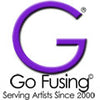
How to Prevent Devitrification
How to use Devit Spray and avoid Devitrification on Glass
What is devitrification of glass (Also called Devit)?
Devitrification can occur when heating your glass for too long at a high temperature. It often occurs when you fire “Float Glass” which is glass with an unknown COE (coefficient of expansion). Bottom line, you are getting undesired results in the look of the glass surface. The glass looses its glossy appeal and becomes dull or crinkled on the surface. Some people call this whitish scum, crazing. This is really the glass molecules changing their structure to crystalline solids.
This can occur due to a lower quality of glass, incompatibility of glass when two different COE glasses are fused together or simply over firing your glass or dirty glass.
Instructions for using Devit products:
We offer Spray A Plus ( Item 41506). It should be liberally applied to the surface of the glass before firing to obtain a glossy surface.
- You can spray or brush lightly on top surface of glass prior to firing the glass in a kiln.
- Spray A Plus will not discolor reds, oranges or other sensitive tones.
- It is 100% lead free, making it safe to use on glass for food surfaces.
- It can also be used on dichroic or iridized glass with no compatibility issues.
- Fire to 1300-1700° F for a glossy, glass like shine.
Tips:
- A foam brush works well to apply a Devit solution but you can also use a Haiku brush, the goal is not to leave lines or bubbles in the application of the Spray A Plus solution.
- Initially mix the product well to get the fine glass particles suspended in the liquid. Then let it sit and do not stir the mixture again. This will leave any crystallized borax in the bottom of the container.
- Clean your foam brush or Haiku brush in distilled water and allow to dry before next use. The presence of dirt or dust on the surface of the glass or even inside a kiln prior to firing your glass can create increased areas of devit.
- Float glass and the use of many stained glasses, not originally intended to be fired in a kiln, are much more vulnerable to devitrification. This is especially true if the glass contains high lime content.
- Opaque glasses are more susceptible to devit simply because the process to make an opaque suspends particles in the glass to give the opaque appearance. This is why clear uncolored glass is the least likely to devit.
How to avoid Devit:
- Clean your glass and your kiln well before each firing.
- Do not hold glass temperatures for long periods at high temperatures.
- Do not combine glass with different COE.
- Avoid rapidly cooling kiln fired glass, allow for a longer and slower annealing process.
Special Notes:
- Devit sprays can be applied to the surfaces of the glass pieces prior to firing but it should not be used as a substitute for proper firing techniques.
- Once devit has occurred, attempting to fix it may not be possible.
Techniques to Try:
- Cover the surface with the same COE clear glass and kiln fire again. Devitrified glass tends to be harder to melt again and the glass can be less stable and fracture later.
- Applying devit spray and kiln firing again may also work.
- Flash Cooling your glass is important if you are having a problem with devitrification, especially if not using a standard COE 90 or COE 96. Devit normally occurs between 1200 and 1300 degrees F. This is why you should always have your firing schedule be faster during this stage. You will not harm anything by opening and closing the kiln often but be careful not to allow the temperature to go down too fast after 1100 F since you will thermo shock the glass.
NOTE: Do not open any peep holes, let it cool down slowly.
Other options:
Sand blast the devit, try etching with an acid bath or polishing it using a brush or pumice stone in an attempt to remove the unwanted surface. Then apply devit solutions and polish fire.
- Choosing a selection results in a full page refresh.
Newsletter
Quick links
Our mission
Promote the Future of Custom Art Glass by providing inspiration thru sharing creativity and knowledge.
Contact Us
Follow us
!
